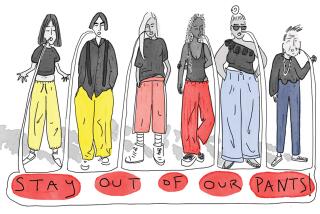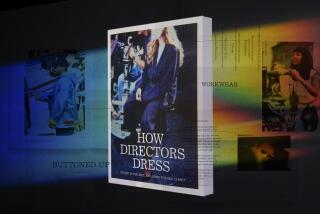Bringing Up the Rear : Suddenly, a Prominent Posterior Is the Seat of Fashion Power
- Share via
Not since the heyday of the cancan has the derriere gotten so much attention. Fashion magazines are flaunting it. Fashion designers are featuring it. And very nice women--as opposed to those considered impolite or naughty--have accepted that accenting the natural curve of the buttocks is tasteful.
Fashion designer Donna Karan, who’s had retail success with her figure-revealing jersey skirts and dresses that cup the backside, admits that she’s been surprised by women’s willingness to show off a well-toned tush. “Now I realize that women are not afraid to display their sensuality. They’re much more confident and have nothing to hide,” Karan says. Even Japanese designer Hanae Mori, whose reputation was built on relatively conservative garb for the blueblood set, is showing tight jersey dresses that highlight the rump. And Emmanuel Ungaro doesn’t even bother with the fronts of dresses in his most recent ads; instead we see the back zippers, the back buttons and, most important, those curvaceous rear ends.
In the editorial pages of a recent issue of Vogue, bottom lines came into focus frequently, especially in the work of fashion photographer Steven Meisel. The models are still twig-thin, but they aren’t posed a la the shy Twiggy of the ‘60s. With posteriors pooched, these women present the liberated silhouette of the late 1980s. Ironically, a similar silhouette marked the sexually restricted late 1880s, the Victorian age of bustles and ruffled backsides.
In her book “The Language of Clothes,” author Alison Lurie says that after the Victorian era, the behind was in style only for a brief period during World War II, when the famous poster of pin-up girl and movie star Betty Grable graced the lockers of soldiers overseas. After that, female fannies were girdled in elastic undergarments until the ‘70s, when panty hose set them free.
Soon, however, a new form of girdle--designer jeans--was firming and flattening rumps. In the late ‘70s and early ‘80s, the rear view of choice was unisex, narrow and flat.
Not so today. With this season’s emphasis on knit skirts, the toned tush is a fashion necessity. A 15-year veteran private fitness trainer, Beth Rothenberg, says of her Southern California celebrity clientele: “They’re always asking for higher, rounder and firmer buttocks. That’s the look, and working the gluteal and abdominal muscles is the only way to get it.”
“The buns are the first place to sag,” says Karen Voight, co-owner of Voight Fitness & Dance Center in Los Angeles. “You’ve got to keep moving the gluts to keep them in shape.” Students at her exercise studio, which offers muscle-conditioning classes specifically for the buttocks, thighs and abdomen, have put an old test to new use: “Now instead of putting a pencil under their breasts, they put it under their buns. If it stays there, they exercise harder and longer.”
“There’s no optimum shape for a rear end,” notes Sharon Lamoreaux, exercise and jazz-dance instructor at Malibu Motion and Santa Monica’s Studio West. “Genes determine the muscle structure of the buttocks and their ultimate shape. But through exercise you can build up the muscle or create a lean dancer’s look.”
Walking and hiking are well-known fanny firmers, and Dr. Daniel Silver, West Coast consulting orthopedic physician for the Joffrey Ballet and a member of the teaching staff at USC / Orthopaedic Hospital, adds jumping rope and using a Nordic track machine to that list. “Roller-skating is also very effective for strengthening the gluteal muscles,” he says, “but one has to balance the rate of injuries against the results.” He cautions that like all exercises, workouts for the buttocks can cause injury if done improperly.
It could be argued that this is yet another step in the never-ending drive toward equality of the sexes. First came the de-emphasis of the breasts; cleavage was a no-no, and dressing for success meant wearing women’s versions of men’s clothing. After playing down one of the most obvious physical differences between the sexes, perhaps the time has come to play up a blatant similarity. A much less sexist way to be sexy, some might say. That is, if “Moonlighting’s” Bruce Willis can wear pants cut to define his seat, it’s only fitting that his co-star, Cybill Shepherd, can wear skirts that do the same.






